- Submissions

Full Text
Environmental Analysis & Ecology Studies
Assessment of Heavy Metal Contamination in Soils Surrounding Bengote Open Cast Mines (East-Cameroon)
Natanael T1*, Jacques E2 and François NG3
1Department of Earth Sciences, University of Yaoundé I, Cameroon
1Department of Earth Sciences, University of Douala, Cameroon
1School of Geology and Mining Engineering, University of Ngaoundere, Cameroon
*Corresponding author:Natanael T, Department of Earth Sciences, University of Yaoundé I, Cameroon
Submission: March 28, 2023; Published: April 24, 2023

ISSN 2578-0336 Volume11 Issue1
Abstract
This study aims at assessing heavy metal contamination in Bangote, Gbafou and Nguesse soils around Bengote Open Cast Mining in Cameroon. In soil samples, heavy metals namely Iron (Fe), Chromium (Cr), Vanadium (V), Nickel (Ni), Copper (Cu), Mercury (Hg), Zinc (Zn), Lead (Pb), Arsenic (As), and radioactive elements Thorium (Th) and Uranium (U), contents were determined using ICP-MS techniques. The heavy metals average concentration in Upper Continental Crust (UCC) was considered background value. Average concentrations of heavy metals in both soils mixed with mining spoil lie above that of the world soil. Pb, V, As and U contents exceed the critical limit value of WHO specified standard.
The mean concentration of Cr, V, Ni, Cu, As, Hg, Pb, Th and U in studied soils are 245.00, 370.00, 8.27, 60, 90, 172.00, 0.18, 3640.00, 28.30, and 4.95mg/kg, respectively. The Enrichment Factor (EF), Contamination Factor (CF), Geoaccumulation Index (Igeo), Pollution Load Index (PLI) are the indices used to assess the contamination risk. The enrichment factor of all the studied metals for all sampling sites are in descending order Pb >V> Cr > As > Cu > Th > U> Ni > Cd. The contamination factor values revealed that Pb and V highly impacted the studied soils. The Pollution Load Index (PLI) values of most samples are >1, indicating the progressive deterioration of soils due to their contamination.
Keywords:Heavy metal; Contamination; Bengote; Pollution; Soil
Nomenclature:Fe: Iron; Cr: Chrome; V: Vanadium; Ni: Nickel; Cu: Copper; Hg: Mercury; Pb: Lead or Sinker; Th: Thorium; U: Uranium; WHO: World Health Organization; km2: Kilometer square; m: Meter; mm/year: Millimeter/year; cm: Centimeter; kg: Kilogram; mm: Millimeter; Log : Logarithm; mg/kg: Milligram/kilogram
Introduction
Global development has devoted a frantic race towards research, exploitation, processing of several types of metalliferous ores. This industry improves the quality of human life by creating jobs, lifespan, skills and knowledge, proper distribution of income, infrastructure, public health services and education [1]. The Cameroon mining industry creates economic growth at the national and regional levels. Mining industry is a human activity with negative impacts on the environment [2,3]. Some negative impacts are habitat destruction, loss of resources and biodiversity, deterioration of land and accumulation of pollutants in various ecosystems [4] as observed in heavy mechanized gold mining in Eastern and Adamawa Cameroon. In addition to acidic leachates and mining residues which cause deterioration of ecosystems, metallic trace elements (TMEs) cause even more harmful effects on the physiological functions of living organisms [5,6]. Therefore, environmental defenders and legislators investigate the impact of mining activity on the three indices of sustainable development: environment, social, and economy [7]. In high doses, metallic trace elements are toxic and can cause major functional complications and serious health problems. Furthermore, certain metals such as lead, mercury or arsenic are very toxic and are classified as pollutants known as “hazardous air pollutants” [8].
Soil is known as the innate action of forces for human beings and key receptor of pollutant hazardous elements (heavy metals and radioactive). Soil is that specific part of the earth’s crust working as open dynamic system whose ability depends on the energetically flux received from the universe [9]. Soil pollution by hazardous elements is a major problem in the world. The abundance, toxicity, non-biodegradable and accumulative properties of these elements are of great concern in surrounding soils. Heavy metals from various sources including mine waste disposal, fossil fuel combustion and plastic waste can accumulate around the mine. They affect soils and plants and cause ecological risks [10]. The evaluation methods used to determine soil pollution by heavy metals are Enrichment Factor (EF), contamination factor (CF) and geo accumulation index. Their enrichment is compared with metal standard values. The methods also assess pollution in mining districts and provide basic information of environmental risks and pollution management in the mining area. They include poor disposal of mine waste, consumption of fossil fuels and occasional discharge of wastewater. The variations of heavy metals in different soil sampling sites were studied.
Experimental Methods
Study area
The study area is in the east region of Cameroon with a surface area of more than 2555km2 in three open cast gold mining, namely Bengote (4), Gbafou (3), Nguesse (3) and their surroundings. The geographical coordinates are between 4°25’59.84’’ and 4°57’40.04’’ North latitudes, and 14°22’00.49’’ and 14°33’45.35’’ East longitudes (Figure 1).
Figure 1:Location map showing the study area.
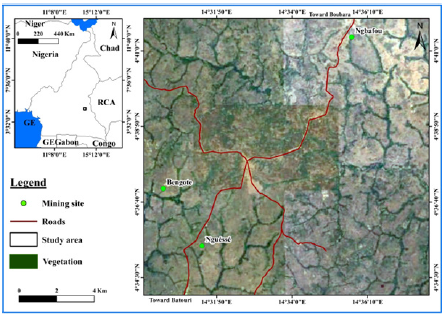
This study area is in the southern Cameroonian characterized by medium altitude (500-700)m and hilly landscape [11,12]. The climate is “Guinean sub-equatorial” with bimodal rainfall of four seasons. The annual precipitation exceeds 2000mm/year between the driest and wettest months. The summer average temperature ranges between 24 °C and 32 °C [13].
Geology and soil of surrounding areas
The study area belongs to the pan-African chain of Central Africa [14]. The geological context indicates Neoprotorozoic granitoids [15], boarded by the trans-Saharan Pan-African chain to the west and the Congo craton to the south. These granitoids intrude high-grade gneisses which represent a paleoprotorozoic basement, likely dismembered during the Pan-African assembly of western Gondwanaland [16,17]. In plutonic environments gold deposits consist of simple veins in second or third order structures such as fissures, linked to crustal discontinuities notably along shear zones in granitic rocks and associated metamorphic rocks [18]. Alterations associated with primary gold mineralization styles in eastern Cameroon include silification, sulphidation, seritization, k-feldspar alteration, with muscovite/sericite formation, haematization, carbonatization and pyritization [11,19]. Pyrite, arsenopyrite, galena, calcopyrite, specular haematite, and gold are primary ore mineral assemblage of quartz veins and veinlets [20]. The mine spoil is composed of weathered products of rocks in the study area (Table 1).
Table 1:Brief description of study area.
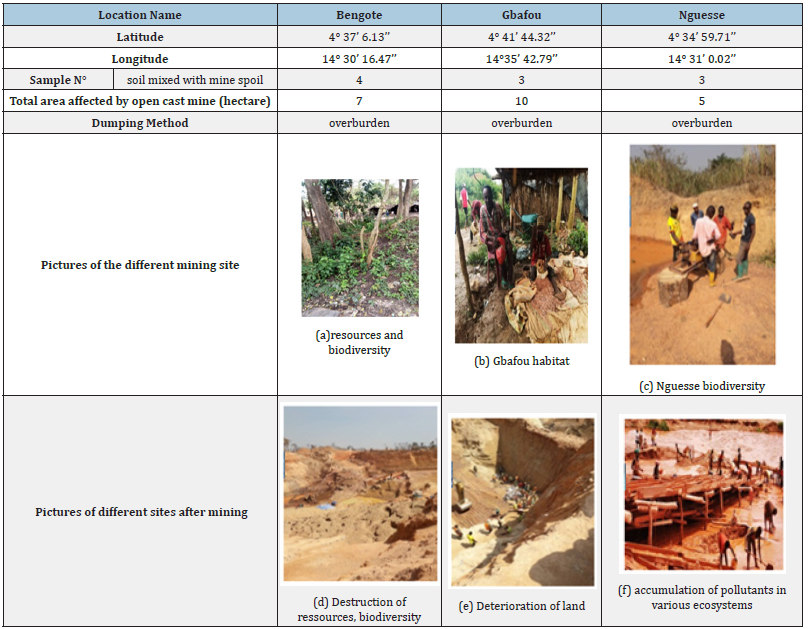
Sample collection
At Bengote, samples in Gbafou, Bengot and Nguesse sites were collected at the top (0-60cm) soil using a Peterson mud sampler (XDB0201). One kilogram of the soil was sampled and stored in plastic packaging bags following the procedure used by [21]. These samples were dried at ambient temperature then ground in an agate mortar, sieved using a sieve of 0.080 mm to remove debris. All the samples were analyzed using the inductively coupled plasma mass spectrometry (ICP/MS) at the Geology Department of the University of Yaounde I. A total of 10 elements were analyzed and include Fe, Cr, V, Ni, Cu, Hg, Pb, As, Th and U of soil samples was obtained using the ‘methods for chemical analysis of silicate’ (AuME-ST43).
Heavy metals indices
The assessment of the levels of enrichment or contamination of the trace elements in soil was carried out using standard pollution measurement indices such as the Index of Geo-Accumulation (Igeo), Enrichment Factor (EF), Contamination Factor (CF) and the Pollution Load Index (PLI).
Geo-Accumulation Index (Igeo)
[22] introduced the geo-accumulation index (Igeo). Originally used with river bottom sediments, it was applied in the assessment of soil contamination (Müller, 1979). In this paper, the soils and debris Igeo of studied mine were computed using the following equation: Igeo = Log2 (Cn/1.5Bn) where, Where Cn is the measured concentration of the given heavy metal examined in the soil or sediment, Bn is the geochemical background value of the element, 1.5 is incorporated in the relationship to account for possible variation in background data owing to lithogenic effects, according to [23]. The geo-accumulation index, consist of seven grades (0 to 6) based on the increasing numerical value of the index and ranges from unpolluted to extremely polluted (Figure 2). The standard Igeo values are presented below (Table 2).
Table 2:Contamination categories based on Igeo.

Figure 2:Igeo-accumulation indices of heavy metals in Bengote soils.
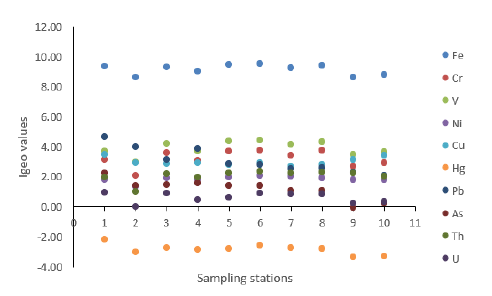
Enrichment Factor (EF)
To find probable source of elements in sediments, the enrichment factor was calculated for each element over the average shale background. Typically, the Enrichment Factor (EF) of elements is stated by the equation EF=(M/Fe) sample/(M/Fe) background, where M background and Fe background are the concentrations of the studied element and Fe in the background, M sample and Fe sample are the mean concentrations of the element and Fe, respectively. Fe is frequently used as a reference element. [24] suggested the use of regional background values which are constant while the contamination levels vary with time and areas. EF values ~1 indicate crust origin, EF < 1 suggest a possible mobilization or depletion of metals [25,26], EF >1 show anthropogenic origin. EFs >10 suggest non-crust source. On this basis there are five contamination categories (Table 3). The contribution of anthropogenic origins also increases with increasing EF values [27].
Table 3:Contamination categories based on EF.

Calculation of the Contamination Factor (CF) and Pollution Load Index (PLI)
he Pollution Load Index (PLI) of a single site is the root number (n) multiplied together by the Contamination Factor (CF) values expressed by the equation: PLI = n√ (CF1 × CF2 × CF3 × … … × CFn), where, n is the number of metals and CF the contamination factor. Harikumar et al. (2009) interpret the PLI values. PLI < 0 indicate unpolluted sediments; PLI=0 indicate perfection; PLI=1 indicate only baseline levels of pollutants, and PLI >1 would indicate progressive deterioration of site quality [28]. The CF and level of contamination advanced initially by [29] and modified by [30] and others are given in Table 4.
Table 4:Contamination levels based on CF.

Results and Discussion
Concentration measurement in ETM in soils
The concentrations of each metal in soil samples, all sites combined are shown in Table 5 below reflects analytical selected heavy metals results and variation in contents according to the metal considered of the soils of the study area. The average concentration of Fe is 85.02g/kg, above UCC and averaging shale values. Under regional conditions of weathering, Fe concentration is important. The concentrations of Cr, V, Ni, Cu, Hg, Pb and As vary widely with an average value of 117.20, 167.63, 5.72, 25.35, 0.05, 582.44 and 34.46 mg/kg respectively. They are higher than UCC except Ni, Hg and U. Pb in all samples exceeds the critical limit of standard set by [31]. The soils, red and very rich in iron oxides, derive from weathering of preexisting rocks mainly granite and migmatite. High Concentrations of metals might occur due to reduction of Fe and Mn oxides and induced pH changes leading to their release from solid phases to the soil solution [31,32]. Except three samples, Pb in soils does not exceed its maximum allowable concentration (300mg/kg) in the whole area because under oxidizing conditions it is strongly sorbed than Cr and Ni [33,34]. The average concentration of other metals (Ni, Hg) is lower than the reference values from UCC [35]. The decreasing average concentration order is Fe > Pb >V> Cr > As > Cu > Th > U> Ni. We see a strong variability of major part of heavy metal concentrations. The analysis of from Table 5 clearly reveals that soils Bengote mines are richer in MTEs compared to soils in periphery of the mine and soils outside the mining area suggesting as well as artisanal gold mining in the Bengote area pollutes the soil by trace elements [4]. The concentrations of selected heavy metals content in soil samples prelevated from different area of study from Bengote Open Cast Mines present variations between 0.012ppm (Nguesse area) and 3640.00ppm (Bengote area). MTEs are having a very high mobility, and they are very easily absorbed by plants. Some of these higher values are considered as toxic [9].
Table 5:Heavy metal concentration in soils around Bengote Open Cast Mines.

Average concentration: AC; Average shale: As; Upper Continental Crust: UCC Sampling stations : Bangote 1 (1), Bangote 2 (2), Bangote 3 (3), Bangote 4 (4), Gbafou 1(5), Gbafou 2(6), Gbafou 3(7), Nguesse 1(8), Nguesse 2 (9), Nguesse 3 (10).
Using the pollution indices for assessment
Contamination measurement indicators used for the assessment of soils in the study area include geo-accumulation index, enrichment factor, contamination factor and pollution load index. Average concentration of background values for world soil used in the various equations. Calculated pollution indices are presented in Tables 6-8.
Table 6:Igeo-accumulation indices of heavy metals in Bengote soils.

Table 7:Enrichment Factor of heavy metals in Bengote soils.

Table 8:Contamination Factor (CF) and Pollution Load Index (PLI).

Geo-Accumulation Index (Igeo)
The minimum and maximum values of Igeo for each metal are shown in Table 6 where, Calculated Igeo values are based on the UCC as background values. The mean values of Igeo decrease in the order of Fe>Pb>V>Cr>Cu>Th>As>Ni>U>Hg. The Pb and V Igeo values (4.7 and 4.06 respectively) indicate strongly to very strongly to extremely polluted, thus the most enriched heavy metals of the study area. For both soil types, Cr, Cu and V Igeo values fall in class 4 (Table 3) indicating strongly pollution. As and Th Igeo values (Figure 3) indicate moderately to strongly pollution. Ni and U Igeo values indicate moderately pollution and Hg falls in class 0 showing no contamination. This indicated that soils in the study area were contaminated by some metals mostly derived from overburden of spoil mine sources. The highest Igeo value for Pb and V in Native soil mixed with mine spoil could possibly be due to mine waste being dumped on open ground not far from the mine. This type of elimination introduces spreading of heavy metals on native soils as a result of weathering and runoff.
Figure 3:Enrichment Factor of heavy metals in Bengote soils.

Enrichment Factor (EF)
The Enrichment factor (EF) is a common tool to assess enrichment degree. Table 7 and Figure 4 shows the enrichment factors (EF) of the heavy metals in soils. The EF values in Table 7 show minimal enrichment in Cr, V, Ni, Cu, Hg, U and Th in both soils. They suggest a deficient source thus a little scope of enrichment. Trace elements assessment using EF at Bengote shows soils extremely enriched in Pb and As, with EF values of 51.82 and 32.65 respectively. However, Pb and As show high EF values (>4) in both major soils. Generally, the natural content of most elements in soils stems from parent rocks while high concentrations relate to mineralization. The higher concentration of Pb and As in major soil sample of the area may be attributed to the gold exploitation and waste storage process. Some studied metals of the area of study (V, Ni, Cu, Hg, Th and U) have EF<1, suggesting a possible leaching of heavy metals from mine waste.
Figure 4:Contamination factor of heavy metals in Bengote soils.
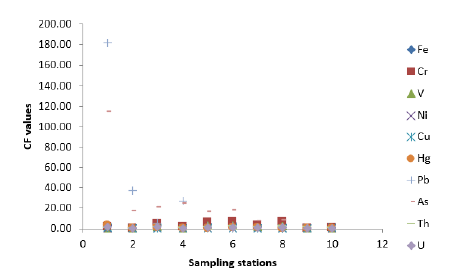
Contamination Factor (Cf) and Pollution Load Index (PLI)
Both Cf and PLI values of elements in soils of the study area are significant (Figure 5) indicating heavy metals contamination. The CF values are presented in respect of Pb. As and Hg are higher than other heavy metals. Anthropogenic activities such as mining have released heavy metals from mining wastes, contributing to their high concentration in soils. Most samples show significant CF values of Pb and As. Pb concentration increase with the soil pH [36]. Calculated PLI using CF values shows moderately to strongly pollution (Table 8). Heavy metal contamination on soil surfaces, particularly at mining sites, is associated with a cocktail of contaminants rather than a single metal [37].
Figure 5:Pollution load index of heavy metals in Bengote soils.
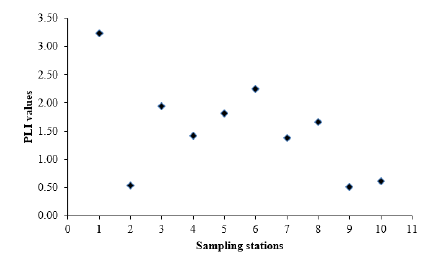
A PLI > 1 in most sites (Table 5) indicates pollution. Ubiquitous mining activities characterized by indiscriminate dumping of mine wastes, tailings and other foreign materials, coupled with intense weathering, contributed to the release and redistribution of heavy metals in surrounding soils. This distribution by natural and anthropogenic processes can result in their deficiency or toxicity (such as Pb, As) to plants and animals. For example, Pb is toxic even at low exposure levels with acute and chronic effects on humans (neurological, renal gastrointestinal and reproductive effects) especially children and pregnant women [38,39] Long exposition to weathering of mine waste probably increased the release of heavy metal in the study area (surrounding soil-water environment). All Cf and PLI values of elements (Ni and Cu) in soil of the area of study are less than one (Figure 5). This indicates that there is no contamination by these elements. The situation of soil contamination in the study area analyzed from the geoaccumulation index, the enrichment factor, the contamination factor and the pollutant load index is recorded in Table 9.
Table 9:contamination’s situation in the study area analyzed from pollution indices.

Conclusion
In summary, the evaluation of the degree of accumulation of heavy metals such as Pb, As, V, Cr etc., in the soil of the Bengote region, calculated using the Geoaccumulation Index (Igeo), the factor d The Enrichment (EF), Contamination (Cf) and Pollutant Load Index (PLI), shows that the soil in the area is heavily polluted by Pb, V, Cu, Cr, As and Th according to the geo index accumulation. Pb and As are also highly enriched in both media when EF is measured. In all indices measured, Ni, and Cu levels in soil remain below once, indicating that the supports are not contaminated by these elements.
The composition of soils in the study area reveals high MTEs levels. The elements must have remobilized from surrounding rocks, coupled with remobilization from widespread sulphides mineralization. Contamination measurement indicators used to assess soils in the study area include geo-accumulation index, enrichment factor, and contamination factor and pollution load indices. The combination of metals in soils is a potential source of toxicity for flora, fauna and inhabitants. In addition, this region experiences subsistence farming, pastoral activity and surface water consumption. These activities constitute another entry of MTEs in the food chain and thus increase the risk of contamination of the population in addition to destruction of ecosystems. The destruction of metallic species participates in the fixation of soil and lessens the diffusion of MTEs thus upsets the previous balance and accentuates the erosion effect. Some plants have adaptive processes to tolerate high MTEs levels in soil. They have significant potential for the development of mine site rehabilitation strategies using phytoremediation approaches.
Acknowledgement
The authors would like to express their gratitude to the people of Kette locality for their invitation to undertake this study.
References
- Koushik S, Kalyan A, Aniruddha G (2012) Assessment of heavy metal contamination of soils in and around open cast mines of Raniganj area, India. International Journal of Environmental Engineering Research 1(2): 77-85.
- Tehna N, Sababa E, Ekoa Bessa ZA, Etame J (2019) Mine waste and heavy metal pollution in betare-oya mining area (Eastern Cameroon). Earth Sciences Research Journal 4: 167-176.
- Mahdi H, Morteza O, Youssef A (2022) Evaluation of positive and negative impacts of mining on sustainable development by a semi-quantitative method. Journal of Cleaner Production 366(13): 29-55.
- Tehna N, Nguene FD, Etame J, Medza Ekodo JM, Noah Tang S, et al. (2015) Impending pollution of Betare-oya OpenCast mining Environment (Eastern Cameroon). Earth Sciences Research Journal 4: 167-176.
- Boularbah A, Schwartz C, Bitton G, Morel JL (2006) Heavy metal contamination from mining sites in South Morocco: 1. Use of a biotest to assess metal toxicity of tailings and soils. Chemosphere 63(5): 802-810.
- Lim HS, Lee JS, Chon HT, Sager M (2007) Heavy metal contamination and health risk assessment in the vicinity of the abandoned Songcheon Au–Ag mine in Korea. J Geochem Explor 96(2-3): 223-30.
- Suppen N, Carranza M, Huerta M, Hernández MA (2006) Environmental management and life cycle approaches in the Mexican mining industry. Journal of Cleaner Production 14(12-13): 1101-1115.
- Lee JS, Chon HT (2003) Exposure assessment of heavy metals on abandoned metal mine areas by ingestion of soil, crop plant and groundwater. J Phys IV France 107: 757.
- Butnariu M, Golan M, Gergen I, Negrea P, Bordean DM, et al. (2004) Study of copper, cobalt, molybenum and zinc correlated with pH in Banat region Rego-soil samples. Macro and Trace Elements: 22 Workshop, Friedrich Schiller University, Jena, Germany, pp. 847-852.
- Kayser A, Schulin R, Felix HR (1999) Mobilization of zinc and Cd in three Swiss soils. Bulletin of the Soil Science Society of Switzerland 23: 43- 44.
- Suh CE, Lehmann B, Mafany GT (2006) Geology and geochemical aspect of gold mineralization at Dimako -Mboscoro, SE Cameroon. Geochemistry exploration Environment Analysis 6: 295-309.
- Vishiti A, Suh CE, Lehmann B, Egbe JA, Shemang EM (2015) Gold grade variation and particle microchemistry in exploration pits of the Batouri gold district, SE Cameroon. Journal of African Earth Sciences 111: 1-13.
- Tsaléfac M (2007) Climate. In: Houstin N, Seignobos C (Eds.), Atlas of Cameroon, Young Africa Editions, Paris, France, pp. 62-63.
- Penaye J, Kroner A, Doumnang JC, Toteu SF (2004) Reconnaissance geochronological survey of Neoproterozoic granitoids in south-western Chad using the single zircon evaporation technique. IGCP Second Annual Field Conference, Garoua, Cameroon.
- Tchouankoue JP, Li XH, Belnoun RNN, Mouafo L, Ferreira VP (2016) Timing and tectonic implications of the Pan-African Bangangte syenomonzonite, West Cameroon: Constraints from in-situ zircon U-Pb age and Hf-O isotopes. J Afr Earth Sci 124: 94-103.
- Toteu SF, Maarten de, Penaye J, Drost K, Tait JA, et al. (2022) Geochronology and correlations in the Central African fold belt along the northern edge of the Congo Craton: New insights from U-Pb dating of zircons from Cameroon, Central African Republic, and south-western Chad. Gondwana Research 107: 296-324.
- Van Schmus WR, Oliveira EP, Da Silva Filho AF, Toteu SF, Penaye J, et al. (2008) Proterozoic links between the Borborema Province, NE Brazil, and the Central African fold belt. Geological Society, London, Special Publications 294(1): 69-99.
- Morrison GW, Rose WJ, Jaireth S (1991) Geological and geochemical controls on the silver content (fineness) of gold in gold–silver deposits. Ore Geology Reviews 6(4): 333-364.
- Groves DI, Goldfarb RJ, Gebre MM, Hagemann SG, Robert F (1997) Orogenic gold deposits: A proposed classification in the context of their crustal distribution and relationship to other gold deposit types. Ore Geology Reviews 13(1-5): 7-27.
- Asaah VA (2010) Lode gold mineralization in the Neoproterozoic granitoids of Batouri, Southeastern Cameroon. Doctoral thesis, Clausthal University of Technology, Germany, p. 202.
- Ekoa Bessa AZ, El-Amier YA, Doumo EPE, Ngueutchoua G (2018) Assessment of sediments pollution by trace metals in the Moloundou swamp, Southeast Cameroon. Annual Research & Review in Biology 30(1): 1-13.
- Muller G (1969) Index of geoaccumulation in sediments of the Rhine River. Geo Journal 2(3): 108-118.
- Loska K, Cehula J, Pelczar J, Weichua D, Kwapuyinski J (1997) Use of enrichment factors together with geo-accumulation index to evaluate Cd, Cu, and Ni in the Rybnik water reservoir in Poland. Water Air and Soil Pollution 93: 347-365.
- Rubio B, Nombela MA, Vilas F (2000) Geochemistry of major and trace elements in sediments of the Ria de Vigo (NW Spain): An assessment of metal pollution. Marine Pollution Bulletin 40(11): 968-980.
- Rashed MN (2010) Monitoring of contaminated toxic and heavy metals, from mine tailings through age accumulation, in soil and some wild plants at southeast Egypt. Journal of Hazardous Materials 178(1-3): 739- 746.
- Szefer P, Szefer K, Glasby GP, Pempkowiak J, Kaliszan R (1996) Heavy metal pollution in surficial sediments from the Southern Baltic sea of Poland. Journal of Environmental Science & Health Part A 31(10): 2723-2754.
- Covelli S, Fontolan G (1997) Application of a normalization procedure in determining regional geochemical baselines. Environ Geol 30(1-2): 34-45.
- Seshan BRR, Natesan U, Deepthi K (2010) Geochemical and statistical approach for evaluation of heavy metal pollution in core sediments in southeast coast of India. International journal of Environmental Science and Technology 7(2): 291-306.
- Chen S, Liang Z, Webster R, Zhang G, Zhou Y, et al. (2019) A high- resolution map of soil pH in China made by hybrid modelling of sparse soil data and environmental covariates and its implications for pollution. Sci Total Environ 655: 273- 283.
- Guo Y, Banett Ag, Zhang Y, Tong S, Yu W, et al. (2010) The short-term effect of air pollution on cardiovascular mortality in Tianjin, China: Comparison of time series and case-crossover analyses. Sci Total Environment 409(2): 300-306.
- Caporale AG, Violante A (2016) Chemical processes affecting the mobility of heavy metals and metalloids in soil environments. Curr Pollution Rep 2: 15-27.
- Alloway BJ (1995) Soil pollution and land contamination. In: Harrison RM (Ed.), Pollution: Causes, Effects and Control, The Royal Society of Chemistry, Cambridge, UK, pp. 318-339.
- Usman ARA (2008) The relative adsorption selectivities of Pb, Cu, Zn, Cd and Ni by soils developed on shale in new valley, Egypt. Geoderma 144(1-2): 334-343.
- Kabata-Pendias A, Pendias H (2011) Trace elements in soils and plants. (4th edn), CRC Press, Boca Raton, Florida, USA.
- Turekian KK, Wedepohl KH (1961) Distribution of the elements in some major units of the earth's crust. Geological Society of America Bulletin 72(2): 175-192.
- Lenart A, Wolny-Koładka K (2013) The effect of heavy metal concentration and soil pH on the abundance of selected microbial groups within ArcelorMittal Poland steelworks in Cracow. Bull Environ Contam Toxicol 90(1): 85-90.
- Chen R, Han L, Liu Z, Zhao Y, Li R, et al. (2022) Assessment of soil-heavy metal pollution and the health risks in a mining area from southern Shaanxi province, China. Toxics 10(7): 385.
- Jaishankar M, Tseten T, Anbalagan N, Mathew BB, Beeregowda KN (2014) Toxicity, mechanism and health effects of some heavy metals. Interdisciplinary Toxicology 7(2): 60-72.
- Latif Wani Ab, Anjum A, Usmani JA (2015) Lead toxicity: A review. Interdisciplinary Toxicology 8(2): 55-64.
© 2023 © Natanael T. This is an open access article distributed under the terms of the Creative Commons Attribution License , which permits unrestricted use, distribution, and build upon your work non-commercially.
 a Creative Commons Attribution 4.0 International License. Based on a work at www.crimsonpublishers.com.
Best viewed in
a Creative Commons Attribution 4.0 International License. Based on a work at www.crimsonpublishers.com.
Best viewed in 







.jpg)






























 Editorial Board Registrations
Editorial Board Registrations Submit your Article
Submit your Article Refer a Friend
Refer a Friend Advertise With Us
Advertise With Us
.jpg)






.jpg)














.bmp)
.jpg)
.png)
.jpg)










.jpg)






.png)

.png)



.png)






